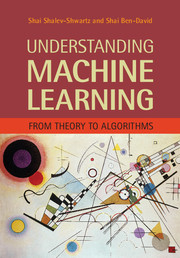1 - Introduction
Published online by Cambridge University Press: 05 July 2014
Summary
The subject of this book is automated learning, or, as we will more often call it, Machine Learning (ML). That is, we wish to program computers so that they can “learn” from input available to them. Roughly speaking, learning is the process of converting experience into expertise or knowledge. The input to a learning algorithm is training data, representing experience, and the output is some expertise, which usually takes the form of another computer program that can perform some task. Seeking a formal-mathematical understanding of this concept, we'll have to be more explicit about what we mean by each of the involved terms: What is the training data our programs will access? How can the process of learning be automated? How can we evaluate the success of such a process (namely, the quality of the output of a learning program)?
WHAT IS LEARNING?
Let us begin by considering a couple of examples from naturally occurring animal learning. Some of the most fundamental issues in ML arise already in that context, which we are all familiar with.
Bait Shyness – Rats Learning to Avoid Poisonous Baits: When rats encounter food items with novel look or smell, they will first eat very small amounts, and subsequent feeding will depend on the flavor of the food and its physiological effect. If the food produces an ill effect, the novel food will often be associated with the illness, and subsequently, the rats will not eat it.
- Type
- Chapter
- Information
- Understanding Machine LearningFrom Theory to Algorithms, pp. 1 - 10Publisher: Cambridge University PressPrint publication year: 2014
- 2
- Cited by

